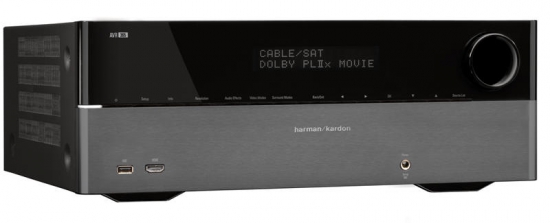Harman/Kardon AVR 365 AV-receiver
This receiver is the eldest of the three in the new Harman/Kardon lineup and most closely reflects the most current trends in a very tough segment in terms of competition.
As you can see, the design of the components of this brand has not changed, so the style is recognizable at a glance. The front panel is divided horizontally into two halves, and the upper, made of dark transparent plastic, is not only a decorative element, but also a protective glass display. From a distance it might seem that there is nothing on the front of the receiver except for the volume knob with the trademark blue and white backlighting and a couple of connectors, but this is not the case - there are narrow black buttons of operational control along the entire length of the partition line. The solution is competent, allowing you to change most modes without using a remote control. Only the main controls remain - the inputs switch and the power button. Speaking of ergonomics we must also mention the screen interface, which graphic is in harmony with the style of the receiver - no flashy icons and fancy tricks with animation, but everything is logical and understandable.
The AVR-365 video output is built on the classic Farouja DCDi Cinema chip, which together with HDMI 1.4 interfaces supports 1080p format with extended Deep Color color gamut. It includes a scan converter, scaler, noise suppressor and a lot of custom image adjustments. If you are too lazy to do so, you can get the best picture quality by setting the Auto Fit mode in the menu.
The sound section is configured as 7.1 with 110 W of power per channel and the ability to supply up to 35 A of current into the load. Digital-to-analog converters work in 192/24 format, all audio signal pre-processing is made by Cirrus Logic CS49700 sound processor, which includes basic surround sound programs. There is a proprietary decompression mode for compressed audio files mp3 Enhancer, which restores lost HF information. The decoders support all currently known surround sound formats, including the rarely seen at other manufacturers Logic7.
Proprietary autocalibration system EzSet/EQ with a remote microphone correctly builds the sound field in a 5.1, 6.1 and 7.1 system configuration, forming the total frequency response taking into account the characteristics of a particular room.
There is a separate connector on the rear wall for wired connection of the iPod, or more precisely of the proprietary Bridge IIIP dock. Playback of files from USB-drives in mp3 and WMA formats is provided, as well as the sounding of the second independent zone. But there are no multichannel line inputs and outputs, which, unfortunately, is becoming a common practice in relatively inexpensive receivers.
The device supports the DLNA protocol, so it can receive audio files via the local network from a computer or media server.
If you want to watch a movie without disturbing anyone, you can turn on the Harman HP mode, in which the multichannel soundtrack is mixed in stereo and fed to the headphone jack on the front panel.
The AVR-365 comes with two remotes with improved ergonomics. All modes and settings can be accessed from the main one, the learning one. It is a large, freely located and illuminated buttons, which are divided into five zones (inputs, audio and video modes, numeric keypad, menu navigation, auxiliary functions). The second, smaller remote, gives access to basic modes that may be needed when operating a pre-configured home theater system.
The receiver was tested with a Sony BDP-S500 Blu-ray player and an LCD TV used to display on-screen menus and monitor the picture. One could feel that the video processor in the receiver was really serious, the picture on the output was even cleaner than on the input - on DVD the MPEG noise disappeared and on Blu-ray the contour sharpness increased. True, the noise suppressor only makes sense to switch it on with the TV tuner, because the picture from the digital source gets a little washed out.
Soundtracks playback was distinguished by convincing dynamics in spite of complicated impedance of the Monitor Audio Gold Reference 20 frontal speakers. It is felt that in the AVR-365 amplifiers are not pulsed, but discrete, working in class AB. The upper range is transparent, no veil, and doesn't seem harsh. Dolby TrueHD and DTS-HD Master Audio decoders make the sound more "analog" and give it a velvety feel, which is especially noticeable on musical soundtracks. In movies the transition to HD-formats is noticeable by the elaboration of distant plans in the rear channels.
When converting the stereo signal to 7.1 format, some stiffness appears in the sound, but it is the hardest mode for the DSP. By the way, the Logic7 decoder is the most delicate one, and it is a pity that not all manufacturers use it due to patent restrictions. The LipSync setting is very clear: the synchronization of the sound with the image is by the color bar in the menu.
The power of the terminal amplifiers is enough to create a real three-dimensional sound picture in the cinema hall of a decent size. The "silent" Harman HP mode is also competently implemented. The only thing that caused a hitch while listening is the difficult access to some needed functions from the front panel.
On the whole, communication with the receiver left a pleasant impression. Extended HDMI switching, two remote controls, auto-calibration system - it is felt that the creators of the receiver took care of its future owner.




